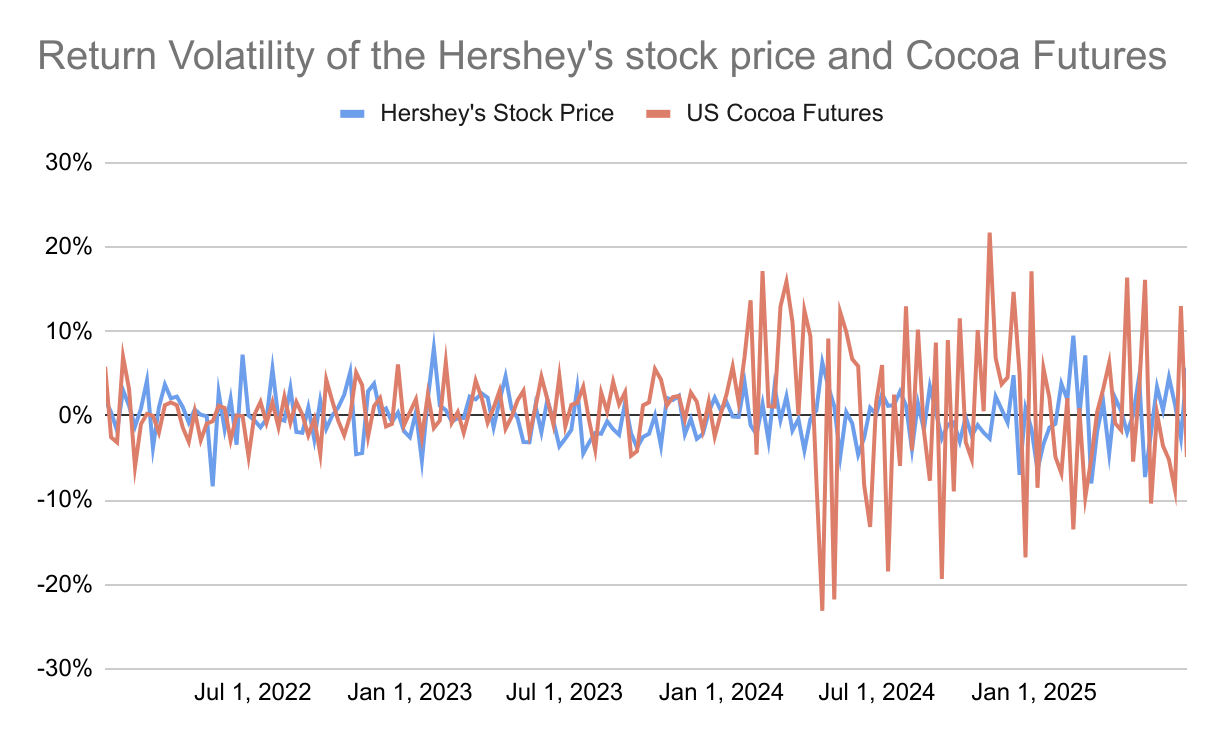One would think that the stock price of Hershey’s, most known for its chocolate products, would fluctuate along with cocoa prices, which have seen massive fluctuations in the last year or so. Guess what, the stock was relatively stable.
Source: Investing.com, Varsity Research
It is not intuitive, but the largest component of a chocolate product is usually sugar. And while confectionery items (mostly chocolate) make up over 80% of Hershey’s revenues, the other 20% comes from savoury snacks. So, it is reasonable that Hershey’s stock price does not mirror cocoa prices.
I came across these facts when I was trying to understand the supply chain of a Hershey’s Hazelnut Chocolate Spread. Why, you may wonder, would I look for a very specific product’s supply chain? Well, I had read somewhere several years ago that a Hershey’s Hazelnut Chocolate Spread travels six countries to reach your breakfast plate.
I wanted to verify if it was true. And what follows is what I found.
The world in a jar - ingredients
Let’s start with cocoa, the primary ingredient of chocolate. The West African countries, Ivory Coast and Ghana, produce over half of the world’s total cocoa. These countries also happen to be the largest suppliers of cocoa to Hershey’s. Apart from these two, Hershey’s sources cocoa from at least nine other countries.
Also, Hershey’s does not necessarily procure cocoa directly from these countries. It works with tens of suppliers across the cocoa-producing countries and several European suppliers to source cocoa products like liquid chocolate.
So, the cocoa might travel through chocolate producers’ plants in Belgium, the Netherlands, Germany, and Switzerland before reaching Hershey’s chocolate spread producing plants.
On a side note, cocoa prices shot up over 130% between 2023 and 2024. The rise continued in early 2025, before subsiding only slightly. Climate change, crop disease, droughts, and unseasonable rains in West Africa hit cocoa yields hard.
You can also listen to this story on Apple Podcasts or Spotify.
But cocoa makes up only 7% of the total content of a Hershey’s spread. Therefore, while Hershey’s chocolate spread became a bit expensive last year, it did not see price fluctuations like cocoa.
The largest component is sugar. It makes up 55% of a typical Hershey’s spread recipe. It sources some sugar domestically in the US and some from Mexico, Brazil, India, and Belize. Sugar prices impact the cost and pricing of Hershey’s chocolate spread the most.
The next largest component is vegetable oil or palm oil, which Hershey’s procures from Indonesia and Malaysia. Palm oil makes up roughly 20% of the recipe.
Then come Hazelnuts, which make up 13%. Hershey’s mainly procures Hazelnuts from Turkey, which accounts for 70% of the world’s hazelnut production. It also procures hazelnuts from Italy and Chile.
And cocoa, at 7% of the total component, is the fourth biggest ingredient in a typical hazelnut chocolate spread.
About 3% of the component is non-fat milk which Hershey’s procures from within a 100 miles radius of its production facility in the US, Mexico, India, and Brazil. Apart from that, it also imports dairy from New Zealand into the US.
If I had to sum it all up, at least 26 countries and six continents contribute to the making of Hershey’s Hazelnut Chocolate Spread.
Sure, not every country participates in the production of every jar of spread. For example, your spread has cocoa from either Ghana or the Ivory Coast or one of the cocoa-producing countries. If only one country contributed a single ingredient, at least six countries would contribute to every single jar of the spread.
The other inputs
If one product traverses so many continents, oil prices can also hugely impact the final price a customer pays. When inputs are shipped from one country to another, fuel is the biggest cost of shipping. In fact, volatile fuel prices in 2023 and 2024 and heightened cocoa prices contributed to the inflation in Hershey’s chocolate spread and other chocolate products. In the US, for example, in 2023, chocolate prices rose by 11.6% while the consumer price index was just 3.4%. As a result of that, consumers purchased 5.4% less chocolate by volume, suggesting a cost-conscious behaviour by consumers.
Then there are costs related to packaging. The type and quality of the jar, where it is sourced from, labelling, etc, also add to the costs.
Reflection
It is not just a chocolate spread, but almost every product of routine use traverses through a complex web of global supply chain before reaching you. But rising tariffs, import quotas, and other international trade barriers are a hindrance to these global networks. We call it protectionism. Any efforts or actions that limit a country’s dependence on other countries are called protectionism. In a world where protectionism is on the rise, do you think countries can really untangle their interdependence?
Is it the bloated egos of people in power and not logic that are weighing heavily on globalisation?
Or is it just a narrative while countries and corporations intend to continue being as globalised as they have been in recent decades?
This newsletter is written by @Vineet_Rajani.
Do read Why does China control Rare Earths? in our newsletter, ‘Tell Me Why’ by Zerodha Varsity.
For any feedback or topic suggestions, write to us at [email protected]
